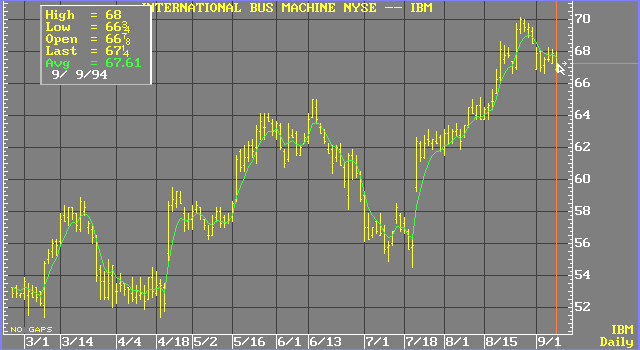Exponential Moving Averages
Exponential moving averages are another form of weighted averaging. In a standard moving average, the oldest price in a fixed series is dropped. By contrast, all prices in a chart influence an exponential moving average: older prices gradually diminish in significance.
Formula:
![]()
Where:
EMAt = current moving average value
EMAt-1 = previous moving average value
SF = smoothing factor:
![]()
where n is the equivalent number of days in a standard moving average.
Pt = current price
The user-definable parameter for an exponential moving average is a smoothing factor. A smoothing factor for an exponential moving average is a number between zero and one (i.e., 0.5). While the equations governing a smoothing factor are complex, the usage of an exponential moving average is simple. Larger smoothing factors approximate shorter standard moving averages. The larger the smoothing factor, therefore, the more responsive the exponential moving average is to current prices.
If you prefer to think in terms of periods rather than smoothing factors, a close approximation of the exponential smoothing factor can be computed using the following formula.
The program can accept weighting parameters as either periods or smoothing factors. If you enter a real number between zero and one (e.g., 0.3) in the Parameters menu, the program will treat the numeric as a smoothing factor. If you input an integer of 1 or greater (e.g., 3) in the Parameters menu, the program will convert the numeric to a smoothing factor using the formula above.

see, P. J. Kaufman, The New Commodity Trading Systems and Methods, New York: John Wiley & Sons, 1978, pp. 64-67.
see, J. K. Hutson,
“Moving Averages vs. Exponential Moving Averages,” in Technical Analysis of Stocks and Commodities, May/June, 1984.See also:Exponential Moving Averages Function